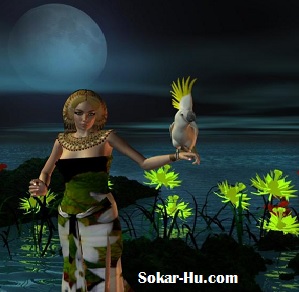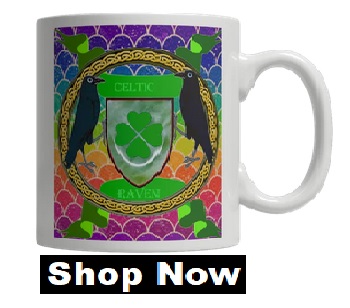Ravens of Valhalla: The Mythic Role of Ravens in Viking Culture
In the age of the Vikings, where the winds carried tales of fierce warriors and Norse gods, the raven soared as an emblem of profound significance. With ebony feathers and sharp eyes, these majestic birds became messengers of the divine, playing a mythic role in Viking culture that transcended the realms of the mortal and the ethereal.
Guardians of Odin's Wisdom
At the heart of the Viking pantheon stands Odin, the All-Father, a figure of wisdom and war. Within his realm of Valhalla, where fallen warriors found their eternal rest, ravens reigned as his trusted confidants and guardians of knowledge. Huginn and Muninn, named "Thought" and "Memory," flew across the skies, whispering to Odin the secrets they gathered from their watchful perch. Their keen observations made them symbols of foresight, ever vigilant in their role as keepers of divine wisdom.
Harbingers of Victory and Battle
In the fierce battles that defined Viking culture, the sight of ravens circling above the battlefield was seen as a sign of favor from Odin himself. The Vikings believed that these feathered messengers signaled the presence of fallen warriors, guiding their souls to Valhalla, where they would feast and fight in preparation for the final battle of Ragnarok. The ravens' presence brought both solace and inspiration to the warriors, instilling in them a sense of invincibility on the battlefield.
Ravens as Soul Guides
Beyond their role in war, ravens were also viewed as psychopomps, guiding the souls of the deceased to the afterlife. Viking funeral rites often included the release of ravens, symbolizing their journey from the earthly realm to the halls of the gods. This sacred duty of guiding the departed souls further established the raven's connection to the divine and the role they played in the eternal cycle of life and death.
Ravens in Norse Mythology
In the tapestry of Norse mythology, ravens featured prominently in the tales of gods and heroes. Huginn and Muninn's presence in Valhalla was just one aspect of their mythic significance. These clever birds were also associated with the god of mischief, Loki, who could transform into a raven at will. Their multifaceted role within the stories spoke to their deep connection with the intricacies of Viking culture, bridging the gap between the natural and supernatural worlds.
Ravenlore and Symbolism
The allure of the raven extended beyond myth and warfare; it found its way into Viking symbolism and art. Raven imagery adorned shields, armor, and banners, serving as talismans of protection and guidance. The raven's presence was a reminder of the divine forces that watched over the Vikings, steering their fates in the tapestry of the gods' grand design.
Legacy of the Raven's Flight
Though the Viking Age has long passed into history, the legacy of the ravens endures in the cultural fabric of modern Scandinavia. Their mythic role as messengers and guardians still captures the imagination, inspiring art, literature, and tattoos that celebrate their wisdom and significance. The raven's flight in Viking culture echoes through the ages, reminding us of the indomitable spirit of the Norsemen and the timeless allure of their mythic beliefs.
Embrace the Raven's Wisdom
In the world of the Vikings, ravens soared as powerful symbols of Odin's wisdom and guidance. Their ethereal presence bridged the realms of gods and mortals, and their role in Viking culture left an indelible mark on the history of the North. Today, as we explore the mythic significance of the ravens of Valhalla, we are invited to embrace their wisdom and foresight, drawing inspiration from these majestic creatures that once graced the skies of ancient Scandinavia.
Ravens of Valhalla: Guardians of the Divine
In the ancient world of the Vikings, ravens embodied the essence of divinity and the strength of Norse beliefs. As Odin's messengers and guides to the afterlife, they held a mythical role in Viking culture that went beyond the mundane. Their presence on the battlefield, their connection to the gods, and their symbolism in art and folklore spoke to the enduring allure of these ebony-winged creatures. Today, as we delve into the realm of the ravens of Valhalla, we honor the timeless legacy they left on Viking culture and celebrate the wisdom and inspiration they continue to bring to our modern world.
- Eyes of the Gods: The All-Seeing Ravens in Viking Mythology
- Feathered Prophets: Ravens as Harbingers of Fate in the Viking Age
- Odin's Messengers: The Sacred Significance of Ravens in Viking Beliefs
- Raven Banner: The Powerful Symbolism of Ravens in Viking Flags and Banners
- Ravenlore: Unraveling the Enigmatic Role of Ravens in Viking Folklore
- Ravens and Magic: Exploring the Shamanic Connection in Viking Culture
- Ravens of Valhalla: The Mythic Role of Ravens in Viking Culture
- Ravens on the Battlefield: Odin's Raven Warriors in Viking Warfare
- Viking Burial Rituals: Ravens as Guides to the Afterlife
- Viking Raven Tattoos: Embracing the Symbol of Wisdom and Power
Odin's Messengers: The Sacred Significance of Ravens in Viking Beliefs
Odin's Messengers: The Sacred Significance of Ravens in Viking Beliefs
In the captivating tapestry of Viking mythology, where gods and legends intertwined with the bravery of warriors, the raven soared as an emblem of sacred significance. With its sleek black feathers and piercing gaze, the raven held a special place in the hearts of the Norsemen, serving as the wise and enigmatic messengers of their chief deity, Odin.
The All-Father and His Feathered Companions
At the pinnacle of the Viking pantheon stands Odin, the All-Father, a deity revered for his wisdom, cunning, and knowledge of the runes. Among his many attributes, his connection with ravens stood out as a testament to their divine significance. Odin had two faithful avian companions, Huginn, and Muninn, whose names translated to "Thought" and "Memory." These wise ravens served as the watchful eyes and ears of the god, soaring across the skies to gather information from the farthest corners of the world.
Harbingers of Wisdom and Prophecy
In Viking culture, the ravens were seen as carriers of divine messages and symbols of foresight. As Huginn and Muninn perched upon Odin's shoulders or flew through the nine realms, they observed and listened to the whispers of both mortals and gods. When they returned to Valhalla, Odin would seek their counsel, drawing from their vast knowledge to shape the course of events. The ravens became symbols of divine wisdom and were revered as harbingers of prophecy, guiding the Norse people in times of both peace and war.
On the Battlefield: Ravens of Victory
The sight of ravens circling above the battlefield was seen as an auspicious sign to the Viking warriors. It was believed that these ebony-winged messengers indicated the presence of Odin, bestowing his favor upon the brave fighters. As the ravens cawed overhead, they were seen as guiding the souls of fallen warriors to Valhalla, the legendary hall where those who died in battle would feast and prepare for the final battle of Ragnarok. The ravens, as symbols of Odin's divine approval, imbued the warriors with a sense of invincibility and courage as they faced their foes.
The Wisdom of Shape-shifting
The connection between Odin and ravens extended beyond their roles as messengers. According to Norse mythology, Odin possessed the ability to shape-shift into various forms, and one of his preferred transformations was that of a raven. By assuming this guise, he could fly unnoticed among the mortal realm, gathering intelligence and seeking hidden knowledge. This shape-shifting aspect further emphasized the deep bond between Odin and his raven companions.
Ravenlore in Viking Art and Culture
The raven's sacred significance found expression in Viking art and culture. It adorned jewelry, coins, and weapons, reflecting its role as a symbol of divine guidance and protection. Viking artisans skillfully crafted intricate designs of ravens, showcasing their beauty and wisdom. These symbols of Odin's messengers were cherished by the Norse people and became talismans that invoked the favor of the All-Father.
Legacy of Odin's Messengers
The legacy of the ravens in Viking beliefs continues to echo through time, leaving an indelible mark on the cultural heritage of the Norse. The image of the wise ravens, perched upon Odin's shoulders or soaring above the battlefield, serves as a reminder of the wisdom and guidance that transcends mortal limitations. In their ebony wings, we find the enduring allure of Viking mythology, a testament to the unwavering faith and reverence the Norse people had for their gods.
Embrace the Wisdom of the Ravens
As we delve into the sacred significance of Odin's messengers, we are invited to embrace the wisdom they embodied. Huginn and Muninn soar through the annals of history as symbols of divine insight and prophetic vision. Their presence in Viking culture serves as a reminder of the power of belief and the enduring legacy of the gods and myths that shape our collective human story.
Odin's Messengers: The Raven's Sacred Flight
In the realms of Viking mythology, the wise and enigmatic ravens, Huginn, and Muninn, stand as the sacred messengers of Odin, the All-Father. Their ebony wings and piercing gaze held a profound significance in Viking beliefs, embodying divine wisdom, prophecy, and protection. As they soared across the skies, these feathered emissaries carried with them the hopes and guidance of the Norse people, leaving a legacy that endures through the ages. In the wisdom of the ravens, we find a reminder of the enduring allure of Viking culture and the timeless power of belief in the divine.
- Eyes of the Gods: The All-Seeing Ravens in Viking Mythology
- Feathered Prophets: Ravens as Harbingers of Fate in the Viking Age
- Odin's Messengers: The Sacred Significance of Ravens in Viking Beliefs
- Raven Banner: The Powerful Symbolism of Ravens in Viking Flags and Banners
- Ravenlore: Unraveling the Enigmatic Role of Ravens in Viking Folklore
- Ravens and Magic: Exploring the Shamanic Connection in Viking Culture
- Ravens of Valhalla: The Mythic Role of Ravens in Viking Culture
- Ravens on the Battlefield: Odin's Raven Warriors in Viking Warfare
- Viking Burial Rituals: Ravens as Guides to the Afterlife
- Viking Raven Tattoos: Embracing the Symbol of Wisdom and Power
Feathered Prophets: Ravens as Harbingers of Fate in the Viking Age
In the mysterious world of the Vikings, where the spirits of gods and mortals intertwined, the raven soared as an emblem of mystic significance. With their sleek ebony plumage and keen intelligence, these feathered prophets played a captivating role in Viking culture as harbingers of fate and messengers of the divine.
The All-Seeing Ravens: Mystical Emissaries of Odin
In the heart of Viking mythology stands Odin, the enigmatic All-Father, revered for his wisdom and cunning. Amidst the pantheon of Norse gods, ravens held a special place as Odin's trusted emissaries. Huginn and Muninn, their names echoing "Thought" and "Memory," graced the skies with their presence, tasked with observing and listening to the tales of gods and men alike. With each flap of their wings, they carried whispers of the world's secrets back to Valhalla, where Odin sought their counsel and divined the threads of destiny.
Ravens: Guides to Valhalla's Halls
To the Viking warriors, death on the battlefield was not the end but a glorious journey to Valhalla, the celestial hall where fallen heroes feasted and prepared for the final battle of Ragnarok. It was believed that ravens, as messengers of Odin, guided the souls of the fallen to this hall of eternal glory. The sight of these ebony-winged birds circling above the battlefield was seen as a sign of Odin's presence and favor, imbuing the warriors with courage and a sense of immortal purpose.
Divine Prophets of Omen
In the Viking Age, the behavior of ravens held profound omens for both individuals and the community. Their calls and movements were carefully observed, interpreted as messages from the gods. If a raven flew overhead from left to right, it was seen as a positive sign, bringing good fortune and divine approval. However, a raven flying from right to left was interpreted as a warning of impending danger or ill-fate. The Vikings heeded these signs, embracing the wisdom of these feathered prophets.
Ravens in Norse Art and Symbolism
The symbolic significance of ravens extended beyond mythology into Viking art and culture. These wise birds were often depicted on jewelry, amulets, and runes, becoming cherished talismans of protection and guidance. The raven's image adorned the sails of Viking longships, imbuing these vessels with divine blessings as they ventured forth into the unknown seas. In their artistic representations, the ravens spoke to the timeless allure of the Norse mythology and the reverence the Vikings held for their winged messengers.
The Enduring Legacy of the Feathered Prophets
As the years have passed, the legacy of the ravens as harbingers of fate endures in the cultural fabric of Scandinavia and beyond. The image of Huginn and Muninn soaring through the annals of history remains a testament to the unwavering faith the Vikings had in their gods and the mystical powers of these majestic birds. Their presence in Viking culture reminds us of the powerful role that belief in the divine played in shaping the lives and destinies of the Norse people.
Embrace the Mystic Wisdom
In the realm of Viking mythology, the ravens stand as eternal symbols of mystic wisdom and divine guidance. As Huginn and Muninn graced the skies, they carried with them the hopes and whispers of the gods, offering glimpses into the tapestry of fate. Their enigmatic presence invites us to embrace the allure of the unknown and to find meaning in the signs and omens that surround us. In the wisdom of these feathered prophets, we find a timeless reminder of the enduring power of belief and the profound significance of the natural world in shaping the course of human destiny.
Feathered Prophets: The Raven's Mystic Flight
In the vibrant tapestry of the Viking Age, the ravens Huginn and Muninn soar as messengers of fate and wisdom. Their ebony wings and perceptive gaze held a sacred significance in Norse mythology, embodying the timeless allure of the unknown and the divine. As they graced the skies with their presence, these feathered prophets carried with them the hopes and whispers of the gods, leaving an indelible mark on Viking culture. In their mystic wisdom, we find an enduring reminder of the profound power of belief and the enigmatic forces that shape the human journey through the ages.
- Eyes of the Gods: The All-Seeing Ravens in Viking Mythology
- Feathered Prophets: Ravens as Harbingers of Fate in the Viking Age
- Odin's Messengers: The Sacred Significance of Ravens in Viking Beliefs
- Raven Banner: The Powerful Symbolism of Ravens in Viking Flags and Banners
- Ravenlore: Unraveling the Enigmatic Role of Ravens in Viking Folklore
- Ravens and Magic: Exploring the Shamanic Connection in Viking Culture
- Ravens of Valhalla: The Mythic Role of Ravens in Viking Culture
- Ravens on the Battlefield: Odin's Raven Warriors in Viking Warfare
- Viking Burial Rituals: Ravens as Guides to the Afterlife
- Viking Raven Tattoos: Embracing the Symbol of Wisdom and Power
Eyes of the Gods: The All-Seeing Ravens in Viking Mythology
In the realm of the Vikings, where tales of gods and heroes resound through time, the raven soars as a symbol of mystic insight and divine knowledge. With their piercing gaze and ebony plumage, these all-seeing birds held a revered place in Norse mythology, serving as the vigilant eyes of the gods and the wise messengers of Odin.
Huginn and Muninn: The Wise Winged Messengers
At the heart of Viking mythology stands Odin, the All-Father and chief deity of the Norse pantheon. Among the many fascinating aspects of his character, Odin had two wise and enigmatic companions - Huginn and Muninn. These ravens, whose names translate to "Thought" and "Memory," flew across the nine realms, observing the deeds and whispers of both mortals and gods. With each journey, they returned to Odin in Valhalla, sharing their insights and secrets, making them the all-seeing eyes of the All-Father.
Divine Knowledge and Prophecy
In Viking culture, ravens were regarded as symbols of divine knowledge and prophetic vision. The sagas recount tales of the raven's ability to foretell the future and guide the paths of both individuals and the community. Their calls and movements were carefully observed, believed to carry messages from the gods. The presence of a raven was seen as an omen, with the direction of their flight carrying deep significance. As the ravens soared through the skies, they brought with them the whispers of the gods and the threads of fate.
Ravens on the Battlefield: Bringers of Victory
On the blood-soaked battlefields that defined the Viking Age, the raven's presence held a special significance. The sight of these ebony-winged birds circling above the warriors was seen as a sign of Odin's favor and approval. It was believed that they guided the souls of fallen warriors to Valhalla, the legendary hall where those who died in battle would feast and prepare for Ragnarok, the final apocalyptic battle. In this role, the ravens inspired courage and invincibility in the hearts of the Viking warriors.
Ravens in Viking Art and Symbolism
The allure of the ravens extended beyond mythology and found expression in Viking art and symbolism. These wise birds adorned shields, jewelry, and banners, becoming cherished emblems of divine protection and guidance. As symbols of Odin's watchful eyes, the ravens graced the sails of Viking long ships, guiding these vessels on their perilous voyages across the seas. The raven's image in art and craftsmanship spoke to the deep reverence the Norse held for these sacred birds and their connection to the divine.
The Timeless Legacy of the All-Seeing Ravens
Though the Viking Age has long passed into history, the legacy of the all-seeing ravens endures in the cultural fabric of the North. Their role as wise messengers of the gods and guardians of divine knowledge continues to captivate the imagination. The image of Huginn and Muninn soaring through the annals of time stands as a testament to the enduring allure of Norse mythology and the deep-rooted faith the Vikings had in the unseen forces that shaped their world.
Embrace the Raven's Wisdom
In the captivating realm of Viking mythology, the all-seeing ravens stand as symbols of insight and divine connection. Their enigmatic presence beckons us to embrace the mysteries of the unknown and to find meaning in the signs and symbols that surround us. In the wisdom of these majestic birds, we discover a timeless reminder of the enduring power of belief and the profound significance of the natural world in shaping the course of human destiny.
Eyes of the Gods: The Raven's Mystic Gaze
In the world of the Vikings, the ravens Huginn and Muninn soar as messengers of divine knowledge and insight. Their keen eyes and ebony wings hold a sacred significance in Norse mythology, embodying the timeless allure of the unseen and the divine. As they grace the skies with their presence, these all-seeing ravens carry with them the whispers of the gods and the wisdom of the ages. In their mystic gaze, we find an enduring reminder of the profound power of belief and the enigmatic forces that shape the human journey through the ages.
- Eyes of the Gods: The All-Seeing Ravens in Viking Mythology
- Feathered Prophets: Ravens as Harbingers of Fate in the Viking Age
- Odin's Messengers: The Sacred Significance of Ravens in Viking Beliefs
- Raven Banner: The Powerful Symbolism of Ravens in Viking Flags and Banners
- Ravenlore: Unraveling the Enigmatic Role of Ravens in Viking Folklore
- Ravens and Magic: Exploring the Shamanic Connection in Viking Culture
- Ravens of Valhalla: The Mythic Role of Ravens in Viking Culture
- Ravens on the Battlefield: Odin's Raven Warriors in Viking Warfare
- Viking Burial Rituals: Ravens as Guides to the Afterlife
- Viking Raven Tattoos: Embracing the Symbol of Wisdom and Power
Viking Raven Tattoos: Embracing the Symbol of Wisdom and Power
In the realm of tattoo artistry, where ancient symbolism intertwines with contemporary expression, Viking raven tattoos emerge as a mesmerizing fusion of wisdom and power. Inspired by the enigmatic Norse mythology, these striking tattoos capture the essence of the raven, becoming inked talismans that adorn the skin with a profound connection to the mystical world of the Vikings.
The Enigmatic Raven: Symbol of Viking Lore
In the captivating tapestry of Viking culture, the raven reigns as a creature of deep symbolism, embodying both wisdom and power. Revered for their intelligence and keen perception, these ebony-winged birds were seen as messengers of the gods, bridging the gap between the mortal realm and the divine. Viking raven tattoos celebrate this enigmatic creature, encapsulating its essence in intricate designs that resonate with seekers of ancient wisdom.
Wisdom and Cunning: The Raven's Dual Nature
Within the Norse mythology, ravens embodied a duality that echoed the complexities of human existence. They were revered for their wisdom and prophetic vision, attributes reflected in their role as messengers of Odin, the All-Father. Simultaneously, their cunning and adaptability represented the survival instincts of warriors and explorers who braved the harsh landscapes of the North. Viking raven tattoos capture this dual nature, symbolizing the balance between intellect and instinct.
Protectors and Guides: The Raven's Divine Role
In Viking beliefs, ravens played a crucial role as protectors and guides. The sight of these majestic birds on the battlefield was seen as a sign of Odin's favor, instilling warriors with courage and the belief in divine protection. Viking raven tattoos carry this sacred role, becoming potent symbols of guardianship and a connection to the gods, guiding wearers through life's battles and triumphs.
Ravens of Valhalla: Embodying the Afterlife
In the Norse concept of the afterlife, Valhalla awaited fallen warriors who died bravely in battle. These warriors would feast and prepare for the final battle of Ragnarok. The ravens, Huginn and Muninn, were believed to guide the souls of these warriors to the hallowed halls of Valhalla. Viking raven tattoos capture the spirit of this mythic journey, becoming emblems of honor and an eternal bond with the fallen heroes of the past.
Intricate Designs: A Testament to Artistry
Viking raven tattoos are intricate masterpieces that require skilled artistry to capture the essence of these mystical creatures. The designs often incorporate traditional Norse motifs like runes, knots, and Mjölnir, Thor's hammer, to enhance the symbolism and significance of the tattoo. Each stroke and curve of the tattoo artist's needle brings to life the wisdom and power of the raven, transforming the skin into a canvas of mythic expression.
Beyond Body Art: A Spiritual Connection
Beyond being mere body art, Viking raven tattoos become a source of spiritual connection for wearers. As they adorn themselves with these sacred symbols, they embrace the wisdom and power of the raven, inviting its qualities to resonate within their souls. The tattoos serve as personal talismans, a reminder of the profound connection between the wearer and the mystical world of the Vikings.
Raven Tattoos: A Living Legacy
In the realm of Viking raven tattoos, artistry intertwines with ancient symbolism, offering wearers a profound connection to the enigmatic Norse culture. With each inked design, the raven's wisdom and power find expression, becoming living emblems of ancient myths and timeless beliefs. These tattoos celebrate the enduring allure of Viking heritage, inviting wearers to embrace the beauty and spiritual significance of the raven's presence.
Embrace the Wisdom and Power
As we delve into the captivating realm of Viking raven tattoos, we honor the enduring legacy of ancient symbolism and spiritual wisdom. Each inked masterpiece becomes a testament to the raven's mystique, a wearable reminder of the Viking reverence for the natural world and the unseen forces that shape our lives. In the wisdom and power of these tattoos, we find an invitation to embrace the mystic allure of Norse culture and to connect with the timeless echoes of the past.
Viking Raven Tattoos: Symbolic Ink of Wisdom and Power
In the realm of tattoo artistry, Viking raven tattoos soar as symbols of wisdom and power, echoing the mystic allure of Norse mythology. With each intricately designed piece, the raven's dual nature as messengers and protectors comes to life, becoming a living emblem of ancient beliefs. Embracing these sacred tattoos, wearers find themselves adorned with the wisdom and power of the raven, connecting them to the mystical world of the Vikings. In the artistry of the tattooist's needle, the enigmatic legacy of the raven lives on, a timeless tribute to the enduring allure of Viking culture.
- Eyes of the Gods: The All-Seeing Ravens in Viking Mythology
- Feathered Prophets: Ravens as Harbingers of Fate in the Viking Age
- Odin's Messengers: The Sacred Significance of Ravens in Viking Beliefs
- Raven Banner: The Powerful Symbolism of Ravens in Viking Flags and Banners
- Ravenlore: Unraveling the Enigmatic Role of Ravens in Viking Folklore
- Ravens and Magic: Exploring the Shamanic Connection in Viking Culture
- Ravens of Valhalla: The Mythic Role of Ravens in Viking Culture
- Ravens on the Battlefield: Odin's Raven Warriors in Viking Warfare
- Viking Burial Rituals: Ravens as Guides to the Afterlife
- Viking Raven Tattoos: Embracing the Symbol of Wisdom and Power





